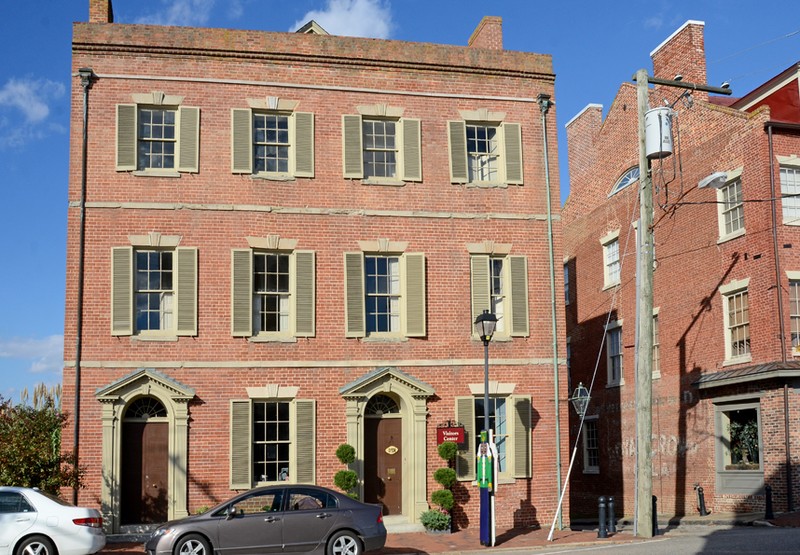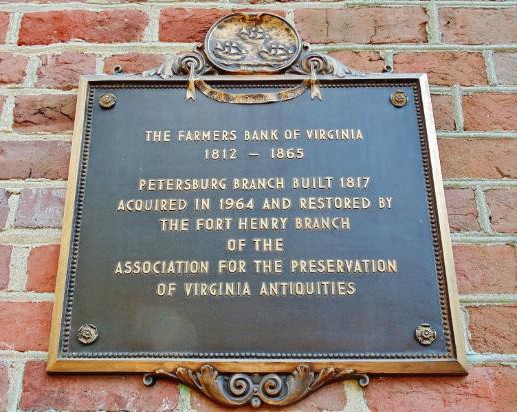Historic Farmers Bank
Introduction
Text-to-speech Audio
The Farmers Bank of Petersburg, established in 1817, is among the oldest bank buildings in the United States. Now a museum, Historic Farmers Bank interprets the history of nineteenth century banking and financial life. It is also home to the Petersburg Visitors Center, where visitors can discover more historical landmarks and cultural events the city has to offer. With its history and beautiful Federal architecture, Farmers Bank was added to the National Register of Historic Places in 1972 and is an important part of the in the Old Town Historic District in Petersburg.
Images
Historic Farmers Bank is a beautiful example of early American architecture and modern preservation efforts. Photo by Preservation Petersburg.

The interior of Historic Farmers Bank, home to a museum and the Petersburg Visitors Center. Photo by Preservation Petersburg.

Plaque commemorating the history and preservation of Historic Farmers Bank.

Backstory and Context
Text-to-speech Audio
Farmers Bank of Petersburg opened during an important moment in the city's history. In July 1815, a fire devastated two-thirds of Petersburg and brought the local economy to a halt. To revive its former prosperity, Petersburg constructed 300 brick buildings over the next two years. Farmers Bank of Petersburg was one of those buildings. The Farmers Bank of Virginia opened the Petersburg branch in 1817 on Bollingbrook Street, once Petersburg's main thoroughfare and commercial center.1
In the early nineteenth century, the largest Virginian banks were chartered by the state. In 1812, the founders of Farmers Bank of Virginia encouraged the state legislature to pass an act establishing their main office in Richmond and branches throughout Virginia. A bank branch like Farmers Bank of Petersburg functioned more independently than they do today. Branches circulated their own notes and stored the money standard within the building, rather than at the main office. This allowed the branch to fully serve its community. Branches also kept strict records of proceedings and debts under the state system, which required banks to be inspected by stockholders and provide annual statements for the legislature. For most of its history, this is how Farmers Bank of Petersburg operated. Banking in Virginia flourished into the 1850s, and Petersburg welcomed two new banks, the Exchange Bank and Bank of Virginia. Like many businesses in this time, the bankers and their families at Farmers Bank lived on the floors above the street-level commercial space. Additionally, the bank grounds included four brick outbuildings: a kitchen, smokehouse, a guard house, and stable and carriage house.2
The 1860s saw two major challenges to the old banking system: the National Bank Act of 1863, which established a federal bank and taxed state notes, and the end of the Civil War, which compelled economic recovery. Farmers Bank of Petersburg's investment in Confederate bonds caused it to go bankrupt. Virginia liquidated its state banks in 1866, and the Farmers Bank of Petersburg was sold and its business accounts settled. In June 1867, John P. Branch, a merchant turned banker, purchased the lot for his private firm, Thomas Branch and Sons. Private banks, or "free banks," had existed as long as the state banks had, slipping through legal loopholes and becoming too pervasive to close without economic fallout. As a private bank, Thomas Branch and Sons accepted deposits, did not circulate its own notes, and worked primarily with young entrepreneurs. John Branch then sold the property to John O'Connor, who established a grocery and liquor store. Subsequently, the building was used as a private residence until given to the Fort Henry Branch of the Association for the Preservation of Virginia Antiquities, now known as Preservation Virginia, in the 1960s.3
Farmers Bank has remained standing as fires and urban renewal took much of Petersburg's early nineteenth century buildings. It is a beautiful example Federal architecture. The building has a boxy, symmetrical structure with windows across the facade. The fanlights above the doors easily identify the Federal style. Preservation Virginia restored Farmers Bank to its 1820s appearance. This meant undoing alterations, such as removing the storefront and rehabilitating the front brick wall. Without original blueprints or photographs, researchers used close examination of the building and Federal buildings of this period to determine its historic look. Inside, visitors can see the reconstructed "strong room," a fireproof space with a trapdoor leading to the basement vault below. The original bank safe is also an impressive artifact on exhibit. Preservation Virginia made use of the grounds, reconstructing the kitchen and adding an herb garden.4
As one of the oldest bank buildings in the United States, Historic Farmers Bank is a unique remnant of Petersburg's past. As a museum and visitors center, it educates and guides visitors to discover the past around them.
In the early nineteenth century, the largest Virginian banks were chartered by the state. In 1812, the founders of Farmers Bank of Virginia encouraged the state legislature to pass an act establishing their main office in Richmond and branches throughout Virginia. A bank branch like Farmers Bank of Petersburg functioned more independently than they do today. Branches circulated their own notes and stored the money standard within the building, rather than at the main office. This allowed the branch to fully serve its community. Branches also kept strict records of proceedings and debts under the state system, which required banks to be inspected by stockholders and provide annual statements for the legislature. For most of its history, this is how Farmers Bank of Petersburg operated. Banking in Virginia flourished into the 1850s, and Petersburg welcomed two new banks, the Exchange Bank and Bank of Virginia. Like many businesses in this time, the bankers and their families at Farmers Bank lived on the floors above the street-level commercial space. Additionally, the bank grounds included four brick outbuildings: a kitchen, smokehouse, a guard house, and stable and carriage house.2
The 1860s saw two major challenges to the old banking system: the National Bank Act of 1863, which established a federal bank and taxed state notes, and the end of the Civil War, which compelled economic recovery. Farmers Bank of Petersburg's investment in Confederate bonds caused it to go bankrupt. Virginia liquidated its state banks in 1866, and the Farmers Bank of Petersburg was sold and its business accounts settled. In June 1867, John P. Branch, a merchant turned banker, purchased the lot for his private firm, Thomas Branch and Sons. Private banks, or "free banks," had existed as long as the state banks had, slipping through legal loopholes and becoming too pervasive to close without economic fallout. As a private bank, Thomas Branch and Sons accepted deposits, did not circulate its own notes, and worked primarily with young entrepreneurs. John Branch then sold the property to John O'Connor, who established a grocery and liquor store. Subsequently, the building was used as a private residence until given to the Fort Henry Branch of the Association for the Preservation of Virginia Antiquities, now known as Preservation Virginia, in the 1960s.3
Farmers Bank has remained standing as fires and urban renewal took much of Petersburg's early nineteenth century buildings. It is a beautiful example Federal architecture. The building has a boxy, symmetrical structure with windows across the facade. The fanlights above the doors easily identify the Federal style. Preservation Virginia restored Farmers Bank to its 1820s appearance. This meant undoing alterations, such as removing the storefront and rehabilitating the front brick wall. Without original blueprints or photographs, researchers used close examination of the building and Federal buildings of this period to determine its historic look. Inside, visitors can see the reconstructed "strong room," a fireproof space with a trapdoor leading to the basement vault below. The original bank safe is also an impressive artifact on exhibit. Preservation Virginia made use of the grounds, reconstructing the kitchen and adding an herb garden.4
As one of the oldest bank buildings in the United States, Historic Farmers Bank is a unique remnant of Petersburg's past. As a museum and visitors center, it educates and guides visitors to discover the past around them.
Sources
1. National Park Service, "Petersburg Old Town Historic District;" National Park Service, "Farmers Bank."
2. Gruchy, "A Sketch of Virginia Banking History," 165-169; National Park Service, "Petersburg Old Town Historic District;" National Park Service, "Farmers Bank."
3. National Park Service, "Farmers Bank;" Bodenhorn, "Private Banking in Antebellum Virginia," 513-535.
4. National Park Service. "Farmers Bank;" "Federal (Adam)." Architectural Styles of America and Europe.
Bodenhorn, Howard. "Private Banking in Antebellum Virginia: Thomas Branch & Sons of Petersburg." The Business History Review 71, no. 4 (1997): 513-42.
"Federal (Adam)." Architectural Styles of America and Europe. Accessed September 2017. https://architecturestyles.org/federal-adam/
Gruchy, Allan G. "A Sketch of Virginia Banking History." Southern Economic Journal vol. 4, no. 2 (1937): 165-79.
National Park Service. "Farmers Bank." National Register of Historic Places Inventory-Nomination Form. Prepared by Virginia Historic Landmarks Commission staff. Washington, D.C.: National Park Service, 1972. http://www.dhr.Virginia.gov/registers/Cities/Petersburg/123-0067_Farmer's_Bank_1972_Final_Nomination...
National Park Service. "Petersburg Old Town Historic District." National Register of Historic Places Inventory-Nomination Form. Prepared by Virginia Historic Landmarks Commission staff. Washington, D.C.: National Park Service, 1980. http://www.dhr.Virginia.gov/registers/Cities/Petersburg/123-0097_Petersburg_Old_Town_HD_Final_Nomina...
Preservation Petersburg. "Historic Farmers Bank." Preservation Petersburg. Accessed September 2017. http://preservationpetersburg.org/museums/farmers-bank/
2. Gruchy, "A Sketch of Virginia Banking History," 165-169; National Park Service, "Petersburg Old Town Historic District;" National Park Service, "Farmers Bank."
3. National Park Service, "Farmers Bank;" Bodenhorn, "Private Banking in Antebellum Virginia," 513-535.
4. National Park Service. "Farmers Bank;" "Federal (Adam)." Architectural Styles of America and Europe.
Bodenhorn, Howard. "Private Banking in Antebellum Virginia: Thomas Branch & Sons of Petersburg." The Business History Review 71, no. 4 (1997): 513-42.
"Federal (Adam)." Architectural Styles of America and Europe. Accessed September 2017. https://architecturestyles.org/federal-adam/
Gruchy, Allan G. "A Sketch of Virginia Banking History." Southern Economic Journal vol. 4, no. 2 (1937): 165-79.
National Park Service. "Farmers Bank." National Register of Historic Places Inventory-Nomination Form. Prepared by Virginia Historic Landmarks Commission staff. Washington, D.C.: National Park Service, 1972. http://www.dhr.Virginia.gov/registers/Cities/Petersburg/123-0067_Farmer's_Bank_1972_Final_Nomination...
National Park Service. "Petersburg Old Town Historic District." National Register of Historic Places Inventory-Nomination Form. Prepared by Virginia Historic Landmarks Commission staff. Washington, D.C.: National Park Service, 1980. http://www.dhr.Virginia.gov/registers/Cities/Petersburg/123-0097_Petersburg_Old_Town_HD_Final_Nomina...
Preservation Petersburg. "Historic Farmers Bank." Preservation Petersburg. Accessed September 2017. http://preservationpetersburg.org/museums/farmers-bank/
